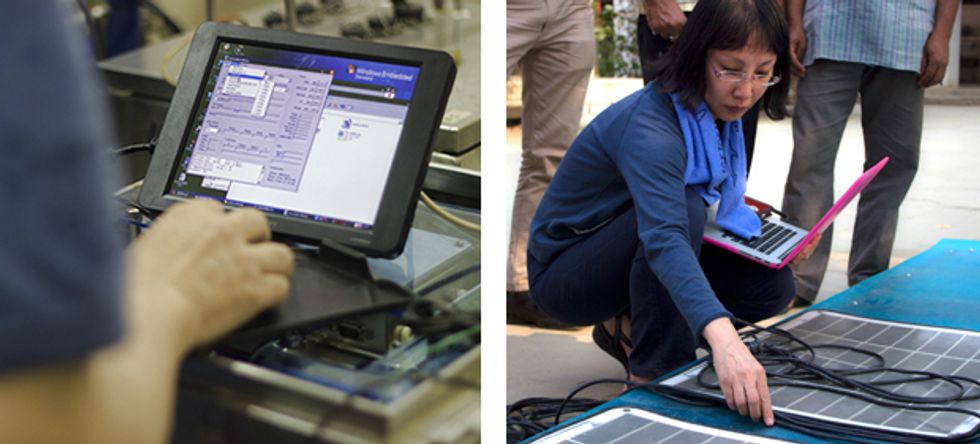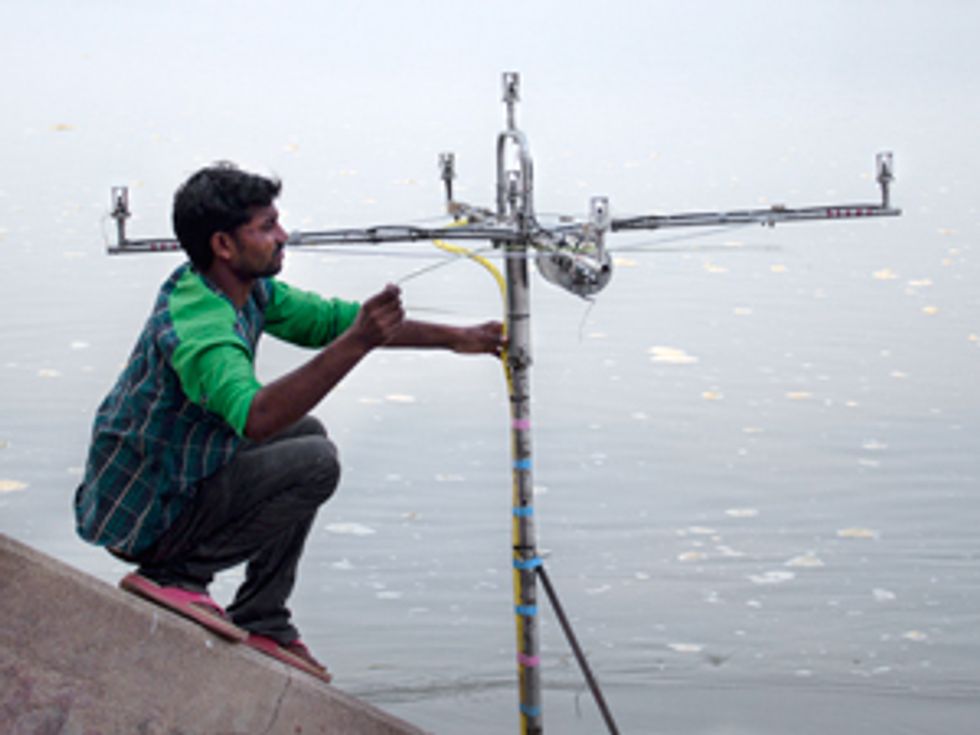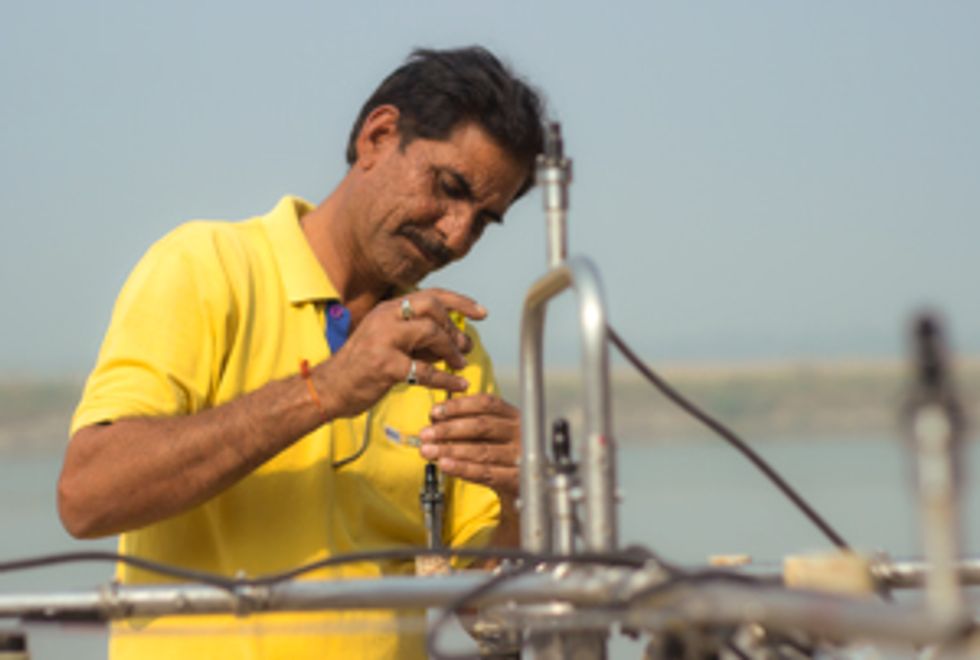Engineers to the Rescue! The Ultrasonic Mission to Save the Ganges River Dolphin
How a Japanese and Indian team of sonar engineers came together to help the endangered Ganges River dolphin
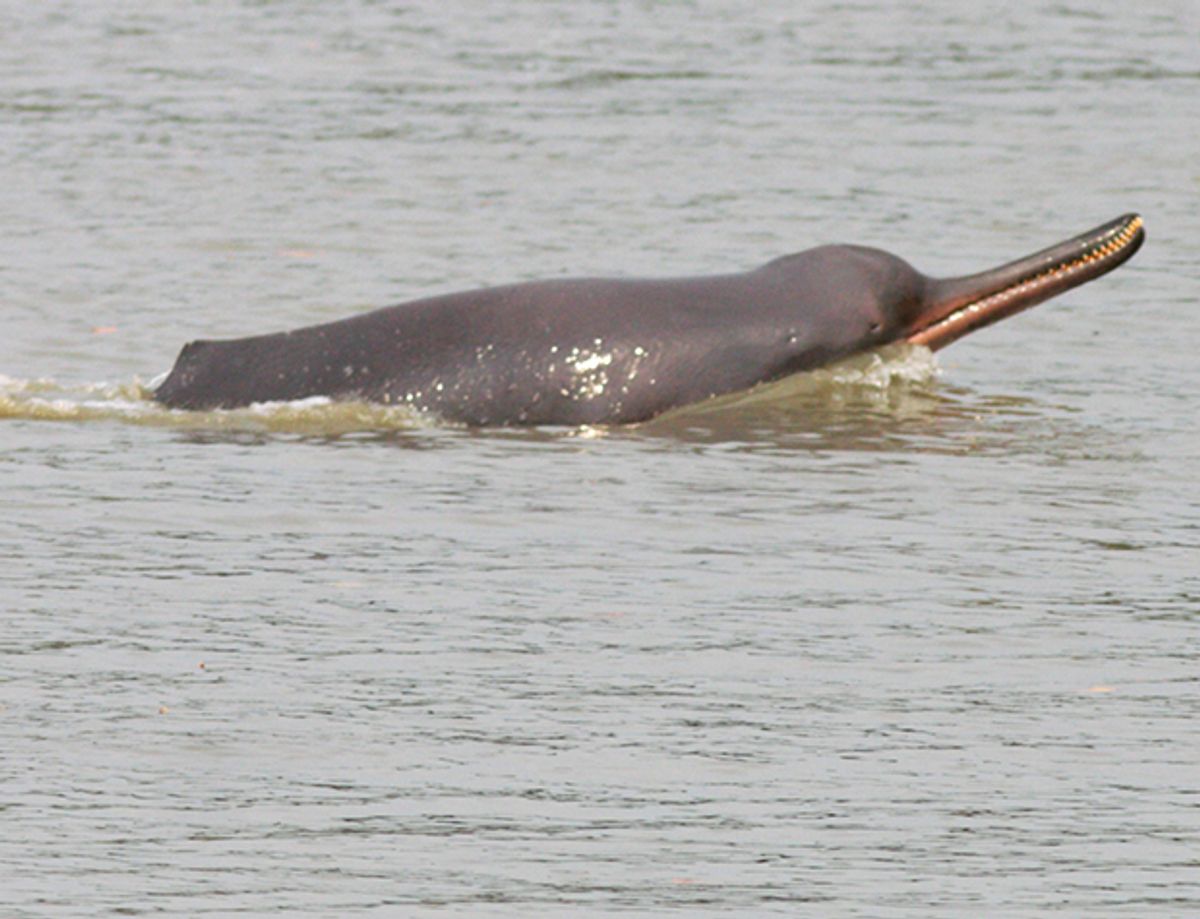
The Ganges river dolphin is both endangered and mysterious; scientists know little about its range and habits.









There’s a fiery sunset tinge on the Ganges as a half dozen engineers and wildlife experts gaze over the water, perched on planks aboard a battered wooden skiff. The water is still along this quiet stretch of river in northern India. A local fisherman handles the sputtering outboard motor as the boat wends slowly downriver, past sandy banks fringed with tall grasses and pocked with holes made by nesting birds.
Suddenly, the sleek gray curve of an animal’s back breaks the water’s surface. In an instant, it’s gone. A few minutes later, a tiny geyser erupts, proof of a blowhole’s puff of air. These fleeting glimpses cheer the band of tired researchers. This is what some of them have traveled from Tokyo to see: the Ganges river dolphin, the most elusive inhabitant of a fabled river.
The boat turns back as the fat red sun sinks into the water, although the researchers have caught only a few flashes of gray. The Ganges dolphin was declared endangered two decades ago, and now fewer than 2,000 of the creatures are thought to exist. Trying to see one is like watching for a shooting star; it takes both patience and good fortune.
That elusiveness is exactly why the researchers have gathered here, 50 kilometers downriver from the industrial city of Kanpur. After this evening’s reconnaissance, the real work will begin tomorrow. Team leader Harumi Sugimatsu, an acoustical engineer, will deploy an experimental sonar monitoring system in the polluted waters of the Ganges, in hopes of tracking the dolphins by the high-frequency clicks they use to navigate and hunt. By eavesdropping on their underwater lives, Sugimatsu believes she can gather data about their behavior and geographical range—data that conservationists can use in their struggle to keep the species from vanishing entirely.
Ganges River Dolphin
Platanista gangetica
Length: ~2 meters
Weight: ~80 kilograms
Population: Less than 2,000
Status: Endangered
Age of sexual maturity: ~10 years
Birth rate: 1 calf every 2 years
Diet: Fish and shrimp
Threats: Fishing nets, pollution, loss of habitat
Extinction is no idle worry: Fifteen years ago, there were three species of freshwater dolphins in the world, living in the Ganges, Indus, Amazon, and Yangtze rivers. Now there are two. China’s Yangtze dolphinhas been considered extinct since 2006, when a research expedition surveyed about 3,500 km of the Yangtze without finding a single one.
Information, Sugimatsu says, may save the Ganges dolphins from that fate. “We want to understand their migration patterns,” she says. If dolphin advocates know where the marine mammals go in their daily routines and seasonal shifts, they can focus protective efforts in the right areas. What’s more, careful parsing of the dolphins’ clicks can reveal surprising details about their activities, such as the locations where they hunt, play, and nurse young calves. Sugimatsu envisions a day when permanent monitoring stations are scattered along key stretches of the river to keep tabs on the roaming animals. “Eventually, we can issue something like a weather report,” she says.
First, they’ve got to prove that their custom-built sonar system can track the slippery creatures. On this mission, Sugimatsu, who hails from the University of Tokyo’s Institute of Industrial Science, is grateful to have ground support from Indian collaborators. Most of the weeklong expedition has been plotted out by Rajendar Bahl, a professor at the Center for Applied Research in Electronics at the Indian Institute of Technology, Delhi. Bahl’s lab primarily does sonar work for the Indian navy, but he has a civilian side as well. He and Sugimatsu began studying marine mammals together in the early 2000s, when they tracked migrating humpback whales around the islands of Japan.
During one of those trips, the Japanese team told Bahl their next ambition: to travel to India and study the Ganges river dolphin. “I said, ‘There are dolphins in the Ganges?’ ” Bahl remembers with a laugh. It’s a telling anecdote. Most Indians don’t know the endangered species exists, let alone have a notion of what must be done to save it.

Along with obscurity, the Ganges dolphin faces the same threats that finished off its Chinese relative: dams that interrupt the river’s flow and divide breeding populations, heavily polluted water, and entangling fishing nets, which prevent the mammals from coming to the surface to breathe. The Indian government has repeatedly declared its intention to protect the dolphins that remain. But these pronouncements haven’t done much good. The most recent river management plan, announced with fanfare in May 2015, admitted that all prior efforts to save the dolphins had “unsatisfactory results.”
Indian officials don’t have a reliable estimate of the dolphin population because their counts depend on visual surveys, explains Viveksheel Sagar, a dolphin expert with India’s Society for Conservation of Nature and a member of Sugimatsu’s team. In a government census, four men in a boat look in different directions, watching for animals that surface to breathe about once every 4 minutes. A single animal can easily be counted multiple times as it surfaces in different spots. “According to the Forest and Wildlife Department [of Uttar Pradesh], the number of dolphins in the river is going up,” Sagar says in an incredulous tone. “My gut feeling is that they aren’t counting correctly.”
The situation also frustrates Bahl, who knows there’s a better way. He has asked India’s Ministry of Water Resources to fund the sonar-monitoring project, which can provide much better tallies of dolphin populations. “I get only nods: ‘Yes, yes, yes, we should do this,’ ” he says ruefully. “But every rupee that’s being spent on this project is from Japan.”
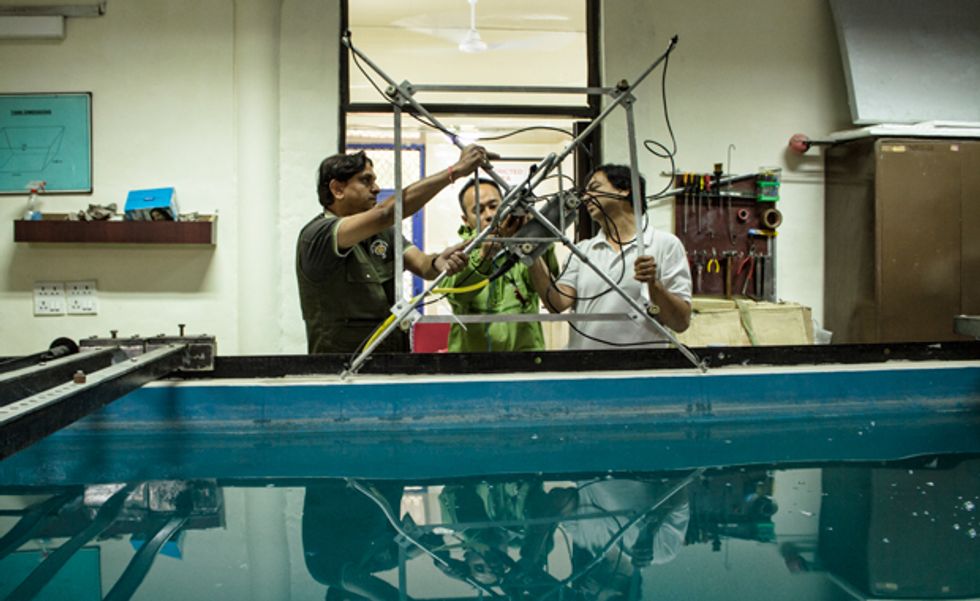
The Japanese team first came to India in 2006 when a solitary river dolphin somehow ended up in the Budhabalanga River, a waterway in the eastern state of Odisha. Sugimatsu calls this creature “the lonely dolphin” because the luckless male was cut off from all known populations of his species. But the loner’s predicament was a boon for science. The researchers realized they could carefully study how this one individual dolphin, isolated within the confines of a narrow river gorge, used his biosonar system in the wild.
The acoustic engineers needed to keep things simple because they had little data to go on. Most of their information about the Ganges dolphin dated from 1968, when American scientists brought a few captured animals to a lab in San Francisco. In their resulting journal article the scientists revealed that the species is nearly blind, with rudimentary eyes that lack lenses. They also professed to be “amazed” by the dolphin’s peculiar locomotion method: It swims on its side while nodding its head rhythmically, producing a lateral scan of its environment. When the biologists dropped a hydrophone into the pool, they picked up trains of ultrasonic clicks.
The scientists might have learned more, but the hardiest of their captives died after 44 days. Still, they saw enough to guess that the Ganges dolphin uses echolocation to create detailed mental maps of its muddy river habitat. Like a submarine moving through the deep, the dolphin sends out sound waves that bounce off underwater obstacles and darting fish.
Nearly four decades later, the Japanese engineers traveled to the Odisha river gorge to study a dolphin in its natural environment. That expedition was led by Tamaki Ura, Sugimatsu’s mentor at the University of Tokyo. The group also included representatives of two partnering companies from Japan: SGK System Giken, which builds hydrophones and other underwater gear, and KDDI, a telecommunications corporation that helped with signal-processing software. The researchers installed their hydrophones in the shallows, with three instruments aligned in a horizontal row and one each above and below. By triangulating the incoming signals, they could determine the lonely dolphin’s location in 3-D and chart its movements.
They quickly made new discoveries about the dolphin’s biosonar abilities. Each individual click, they found, lasted 40 microseconds, and the animal emitted these pulses at an average frequency of 65 kilohertz. Oddly, though, the hydrophones picked up intermittent strings of clicks, not long steady streams. The researchers realized that the Ganges dolphin generates a narrow sonar beam that it sweeps back and forth, as if swinging a flashlight to illuminate a large area. The row of hydrophones detected the signal only when the narrow beam pointed its way. The discovery was a valuable contribution to mammalogy, and also a challenge for Sugimatsu. Her team needed to build a better dolphin detector.
The morning after their sunset reconnaissance cruise, the core team of Bahl, Sugimatsu, Tomohiro Kawabata of SGK System, and Junichi Kojima from KDDI’s R&D labs emerge early from their hotel in the dusty town of Fatehpur. They climb into waiting cars and hold on tight as the drivers slalom through traffic on chaotic highways and then rattle down rutted dirt roads, horns blaring to clear the cows. The cars judder past the fallow fields of late November as day gradually brightens the gray, polluted sky. India is booming—its economy is growing faster than China’s, according to the International Monetary Fund. But the toll on the country’s environment is harsh. The air is heavy with haze, and the Ganges, the Hindus’ sacred river, is clotted with sewage and industrial waste.
In some parts of the river, the dolphins are hanging on. After their initial study of the lonely dolphin, the sonar engineers moved to a peaceful and relatively clean site about 150 km south of New Delhi. Sugimatsu describes that location, a 12-km stretch of river between two dams, as “a kind of sanctuary” for dolphins. There, working in the dry seasons over six years, her team refined their sonar equipment and techniques for long-term monitoring.
Now, 400 km downriver from that tranquil locale, they’re ready to put all they’ve learned into action in a harsher habitat. Here, the mammals must contend with many hazards, including fishermen who ply the river with nylon nets and pollution pumped into the water by tanneries.
In the months leading up to this trial, Bahl worked with local conservationists to find a suitable location. This experiment calls for long-term monitoring, so the team’s equipment will remain submerged and active long after the Japanese researchers fly home. The team settled on a ghat, or bathing place, with wide cement steps leading down to the water. It’s a bustling spot. Men stop by to bathe and women come and go with laundry, batting away the brownish scum on the water’s surface to make space for their linens. The riverbank’s litter includes heaps of tiny clay cups, which carried flickering flames downriver during the recent festival of light.
It doesn’t look like a habitat for rare aquatic mammals, yet Sagar, the conservationist and dolphin expert, is sure they’re out there. This spot lies in the middle of a 140-km length of river that’s not partitioned by dams, Sagar says, which allows for a “free-living population.” While the animals benefit from this expanse, it also makes the proposition of finding them much more difficult. “They could be anywhere,” he says.
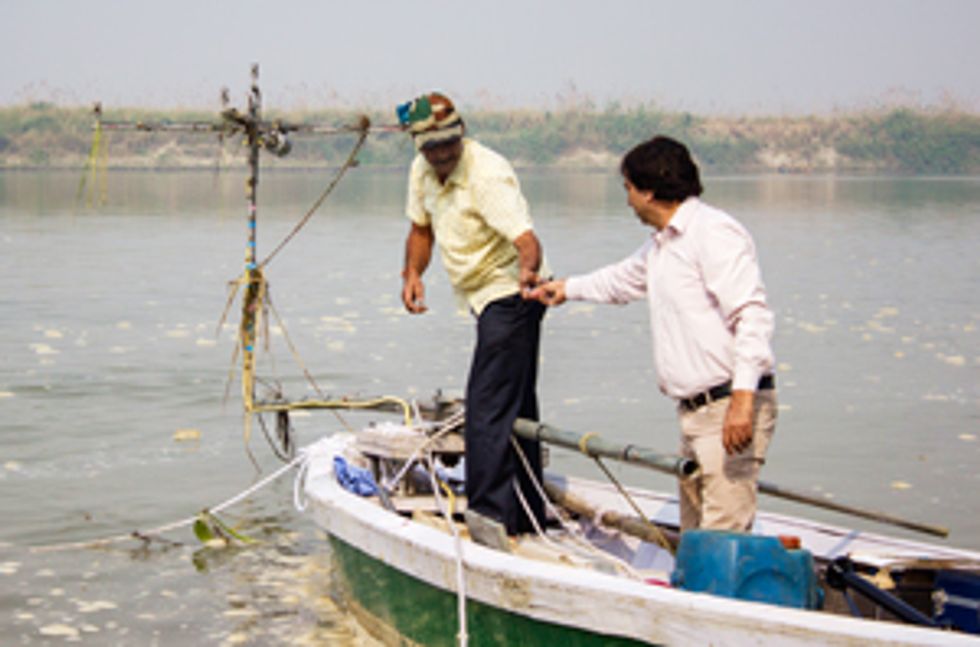
On the steps of the ghat, the Indian and Japanese researchers unpack equipment and start assembling the hydrophone system, calling out instructions in a mélange of Hindi, Japanese, and English. Curious kids stand in giggling clusters, watching their every move. Meanwhile, local men tie up a green and white rowboat, positioning it with its stern abutting the ghat’s concrete landing and its prow jutting out into the current. They toss out anchors to keep it securely in place. The hydrophone system will dangle in the water suspended from this boat’s prow.
The line of individual hydrophones used to study the lonely dolphin has been replaced by a single piece of equipment holding six hydrophones. These sensors are arranged to pick up sounds coming from every direction, so they’ll capture more sonar beams as passing dolphins scan back and forth. The new array consists of two metal pipes that cross to form a big X measuring 160 centimeters along each axis. A hydrophone hangs from each endpoint, a fifth sits in the center of the X, and the sixth is attached below that center point.
“Each pair of hydrophones is like a pair of ears,” Bahl says, as he watches workers assemble the apparatus under the hot morning sun. To locate the source of sounds, the system uses triangulation: A dolphin click traveling at the speed of sound through the water (roughly 1,500 meters per second) reaches one endpoint hydrophone a fraction of a millisecond before the other. The hydrophone in the middle acts as a “third ear” to provide another data point, and thus more precision. The system then calculates how far that sound traveled to reach each hydrophone to determine the dolphin’s direction and distance. For every 40-microsecond click, the system runs the calculation for both sets of “ears.”
The fifth and sixth hydrophone enable the system to determine an animal’s depth. The array also incorporates a compass, GPS, and an inclinometer so the software can compensate for movements and tilt. It’s entirely passive—it listens for pings, but doesn’t send any out—so it doesn’t alter the dolphins’ behavior. During a midmorning tea break at the ghat (in Indian science, there are frequent tea breaks), Bahl explains that the system can pinpoint a dolphin’s location to within a few meters, making it precise enough to track individual creatures.
When the instrument is assembled, a few local men carefully tote it down the ghat steps and into the waiting rowboat. The men attach the X-shaped array to a long steel pole fastened securely to the prow, and then, as the engineers watch anxiously, lower the apparatus into the water. The hydrophone system sways in the current, but is held in position by the pole. The team is satisfied with its placement, as the hydrophones are well out into the river’s flow and will be able to catch sonar beams coming from many directions. Still, they ask their helpers to haul it up and do the dunk again. They forgot to take photos the first time.
“The dolphins came!” Sugimatsu exclaims the next day. It’s breakfast time on day two, but she’s neglecting her spicy masala omelet in her excitement. Overnight, the underwater monitor recorded 11 different episodes of sonar activity in its vicinity. The hydrophone rig that dangles from the rowboat’s prow sent its raw data to a boxy processor that sits inside the rowboat; that signal processor analyzes, stores, and transmits data, uploading it to a server in Japan in real time. Sugimatsu can therefore access her click-analysis program from anywhere via the Web. This morning she’s been checking for dolphins from her hotel room, and when she flies home she can keep studying the animals from her lab in Tokyo.

The team can learn a lot from simple strings of clicks. They can look, for instance, at time intervals: A dolphin sends out more frequent clicks while hunting so it can more precisely track its prey. They’ve also detected specific click patterns when a dolphin group includes young calves. Some of the sophisticated signal processing comes from Bahl’s work for the Indian navy on tracking enemy subs. His algorithms filter out environmental noise to isolate the dolphin’s microseconds-long clicks, compare the raw data from six hydrophones, correct for the rig’s roll and pitch, and do it all within milliseconds to produce real-time data.
But such detailed analyses depend on clean signals, and during day two, the researchers begin to worry that such signals will be hard to come by in the current location. By midday, the ghat is crowded with bathers. Barefoot young men working as an informal construction crew are hurling stones into the water, building a rough baffle to protect a section of the riverbank from erosion. The engineers make an important decision: They need to decamp to a quieter ghat 2 km downstream.
On day three they make the move and settle in at the new site, preparing the equipment to remain in the river for six months, until the monsoon comes. To gather basic environmental data, they hang a sensor from the boat to measure the water’s temperature and salinity. Having learned from hard experience not to rely on India’s power grid, they set up a generator, a battery, and solar panels, a redundancy of power sources that should keep the system running no matter what. Eventually, if the team finds funding, many such stations can operate autonomously for months at a time, transmitting data from up and down the Ganges.
The team has one more crucial task to fulfill before they can declare their mission off to a successful start: They need to conduct a census of the local dolphin population that calls this stretch of river home. For that undertaking, the stationary array is of no use. The researchers need to cruise the river and find the dolphins wherever they’re hanging out.
So on the morning of day five the team members clamber into the rickety motorboat again, ready to deploy a mobile sonar tool of their own invention. They’ll tow it behind the boat, and the four small hydrophones clustered at its end will listen for nearby dolphins’ clicks. It’s connected to a signal processor, which in turn connects to a laptop.
On this boat ride, the researchers aren’t staring out across the opaque water, hoping for a flash of gray. Instead, they hunch over the laptop that’s streaming data from the detector trailing in the boat’s wake. A few kilometers upriver the laptop’s screen suddenly lights up with lines of blue dots. Each streak represents a slippery gray creature gliding through its underwater world—invisible, but now accounted for.
Four dolphins appear to be frisking in the shallows at that location. Before lunchtime the researchers canvass nearly 7 km of the river and locate a total of 14 resident dolphins. But they also come across fishermen trawling with nylon nets—the type that most often ensnare the mammals, says Sagar, the conservationist. This sonar census will have immediate results. Now that Sagar knows about this “dolphin hot spot,” he’ll plan education campaigns for the local fishermen.
Sugimatsu hopes that many more such surveys will provide an accurate tally of the endangered dolphins that still swim the Ganges. She imagines Indian researchers using mobile tools for rigorous census taking, and using a series of stationary monitors to record the animals’ migrations along the river. Over time, she says, wildlife biologists will learn what the species needs to survive. But Sugimatsu has already identified a few of the necessities: “Science, statistics, data—these are good for the dolphins.” Spoken like a true engineer.
This article appears in the May 2016 print issue as “The River Dolphin’s Distress Call.”

